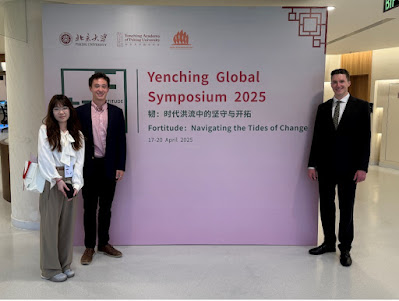Spring Break Trip to Yunnan: Exploring China's Borders
 |
|
Our team in front of Yunnan University!
|
On early Saturday morning, we took the fast train from Nanjing to Yunnan’s capital, Kunming. It was 7 hours filled with talking, eating, sleep and gazing out the window at the changing Chinese southern landscape. We spent a couple days exploring Kunming through the Yunnan museum, the Ethnic minority museum, and an Ethnic minority village. We conducted interviews in Chinese with Green Watershed and The Nature Conservancy, two environmental NGOs that shared about the current successes and challenges of NGOs in China. At the Institute for Indian and Ocean Economics, we interviewed two professors about the economic relationship between China and its southeast neighbors as well as the impact of the One Belt One Road project on diplomatic and economic relations.
 |
|
Interviewing at the Institute for Indian and
Ocean Economics
|
Kunming proved a beneficial trip for understanding border relations. However, Ruili captured my heart. It is a city that sits in the corner of western Yunnan, wedged between the China-Myanmar borders. Southeast Asian influence is prevalent there, and the Dai ethnic minority culture is also interwoven with the culture of the city. Its subtropical climate was evident from palm trees that lined the streets and consistent rain for hours on end even though the sun still shined. We visited trade ports where gateways and fences separated China and Myanmar. Watching people with blue and maroon border passes hustling and bustling around the port, made me realize that borders are porous. Often times, people cross borders when they’re running away from or toward something. A young Myanmar woman told us earlier that most Burmese residents come into China for work, others have families in China, while some were moving away from more violent situations in Myanmar. We caught glimpses of Myanmar from our side of the fence as these thoughts ran through my mind.
 |
|
If you look closely, you can see Myanmar!
|
Later, we visited a Dai ethnic minority village that was sectioned off and preserved on the outskirts of city. The architecture of their temples and the clothing styles the women wore resembled that of the Myanmar women and men we saw earlier throughout the day. They wore long pieces of material tied around their wastes like colorful maxi-skirts to dress for the hot tropical area. The Dai’s cultural symbol is the peacock which was displayed everywhere in different parts of the village. Through observing and researching on the character for Dai (傣), we found that they were descendants of Thai peoples from many years ago who used to control the area through their own kingdom. Now, they were integrated into Chinese society making up one of the 55 ethnic minorities of China.
 |
| Entrance of the Dai village |
On the last day of our exploration, we visited the Ruili Women and Children Development Center, an NGO that was specifically designed to offer health and life services to Chinese, Dai and Myanmar women and children. They shared about their health and orphanage programs, volunteer opportunities and the work of their office in Mynamar. This organization exemplified the value of NGOs in border city areas; they blindly helped those in need regardless of cultural background and with respect to cultural heritage. Interviewing this organization really opened my eyes to different parts of Chinese society and helped put faces to societal situations that are often discussed at HNC. It was truly a time well spent for Spring Break.
 |
|
After the interview with the Ruili Women and
Children Development Center
|
The HNC Spring Break field research trips were jointly funded by the HNC Chinese and American administrations as part of an initiative to develop innovative teaching and learning opportunities at the HNC which bring together Chinese and international students to address course topics. The American funding was thanks to a generous donation by Jill McGovern.


